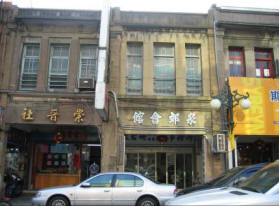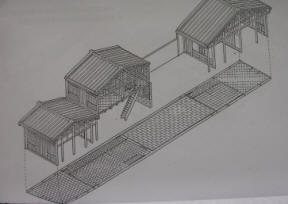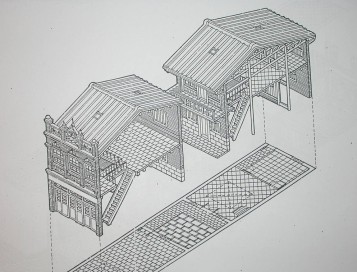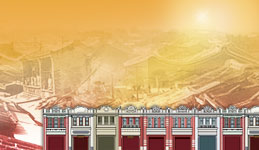          

|
|

|
 Origins of Street House
Origins of Street House
During the Ching Dynasty, the Old Street was not enough for business
activities, which led to the internal expansion and eventually the
formation of "No sky" street. This new street (the surrounding areas
of Wu-Fu Street) became the most important business center of Lukang. As
a result, the development of the street-houses on Wu-Fu Street was quite
different from that of Pei-Tou. Compared with the street-houses of
Pei-Tou, the street-houses of Wu-Fu Street were more like those on Yao-Lin
Street and Pu-Tou and were in a better organized pattern, apparently
under a meticulous plan—a plan
collaborated by the guilds
and the locals.
|
 |
 |
|
Cyuan Jiao
assembly hall |
Street house
in Cin dynasty |
|
 Characteristics of Street House
Characteristics of Street House
The
development of Wu-Fu Street during the Ching Dynasty was different from
earlier times in the following ways: developing in a certain period of
time, similar house designs, and similar size for streets, which were
meant to boost the development of business activities. Therefore, there
should be a consensus on the development of Wu-Fu Street and there could
be some regulations about the development. Yet it is a pity that the
evidences for the consensus and the regulations are nowhere to be found
now. Besides, the street-houses on "No sky" street were similar to
the Chuan Chou-style, which shows the development might be closely
related to the leading guild, Chuan Chou Guild.
 TOP
TOP
|
|
 Design of the Street Houses
Design of the Street Houses
The design of the street-houses on "No sky" street originated from
the Chuan Chou- and Chang Chou-styles. The main framework was made from
wood. The walls between houses were made from clay or knit bamboos with
mud, which were replaced by bricks plus wood on the top (the roofs) as
time went by. There were
wells inside the houses to deter burglary and
for business, which became the major characteristic. Another
characteristic is that the street-houses are in an oblong layout, quite
different from the houses in other ports. This characteristic might be
closely related to the land planning and the space management.
|
 |
|
Street house
in late Cin dynasty |
 TOP
TOP
In terms of the spatial functions and the façade, the street-houses at
that time had two, three, or four compartments—each compartment for
different purposes. The facades were made from wood or bricks, differed
in styles—some were even burglarproof. So much for this topic. In a
word, since the owners of the street-houses during the Ching Dynasty did
not plan for long-term residence and shuffled between Taiwan and the
mainland, the street-houses were nothing but
business-oriented and
similar in design, which manifests the role of "No sky" street as
the business center of Lukang and the differences from the street-houses
of the Japanese Colonial Period.
|
|
《Next
New House…》 |
|
|



